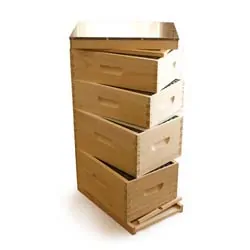Though each bee within a honeybee colony and the role they play is important, the queen bee’s role is possibly the most important one and has a direct influence on all the bees and their behavior within a colony.
- Reproduction: A honeybee queen who has successfully mated with a drone is the only one in a colony who can lay eggs. And she’ll lay a lot of them, up to 2000 per day during the spring and summer months when brood rearing is at its peak. Though she won’t necessarily do so every day, her primary function is to lay eggs and aid in the growth of the colony’s population.
- Communication: In addition to buzzing, queens use pheromones to communicate with the other bees in the hive to directly impact their behaviors, affecting everything from foraging to maintaining social harmony within a colony.
- Honeybee queens also emit a very special pheromone, called the “Queen Pheromone”, that tells other bees that she is present and laying eggs inside the hive. If the queen dies or begins to run out of stored sperm and stops laying eggs, the lack of a queen pheromone may cause conflicts and agitation within the colony and will tell workers that they must replace their queen, this is called “Supersedure”. (Learn more about re-queening and queenlessness in the “Read More” section below!)
- Lifespan: A queen’s lifespan is quite different from other bees and allows her to live for years, compared to the weeks or months that workers and drones will live.
- Anatomy: For a queen to play her very special role in the colony’s reproduction, her anatomy must be special, too. Her body is much longer which allows her to reach deep inside cells to lay eggs at the bottom and because her body is so much larger, the cell size and development time of a queen honeybee varies from other bees, too. (Queen development time is very helpful to understand as it may impact your beekeeping tasks, check the “Read More” section below for more details on the importance of this.)
- Unlike other bees who die when they sting something or someone, a queen is equipped with a special stinger that has no barbs to get stuck in your skin, so she can sting as many times as needed to defend herself against a threat. *Given a queen’s stinging prowess and importance, it’s best to take extra care and special precautions when handling your queen, especially if you suspect you may have a bee sting allergy.
Knowing Your Hive’s Queen-Right Status
As a beekeeper, it’s essential for you to know what to look for to indicate a healthy queen is present and laying eggs inside your beehive, also known as being “queenright”. It’s equally important to know what you should do if you can’t find those signs. Joining an online beekeeping community like PerfectBee’s Colony or your local beekeeping club can help connect you with other beekeepers who will be glad to help you in many ways, especially with sharing resources and determining your colony’s queenright status and health level.
Read More
Why and When to Consider Requeening
The Role of the Queen Honeybee (In-Depth Academy Lesson) *
Queenlessness in Your Beehive *
How Honeybees Use Pheromones *
* Colony Member-Only Content
